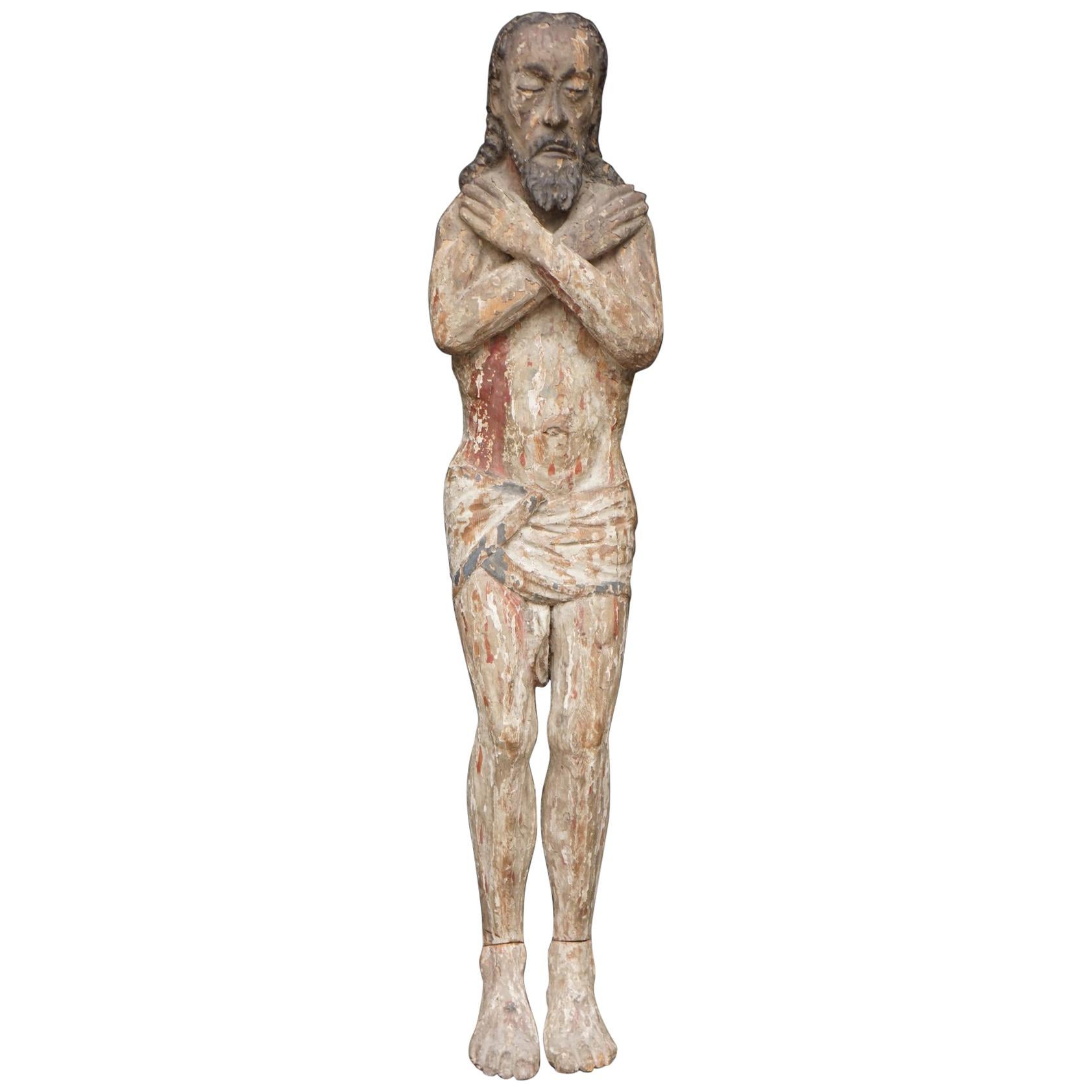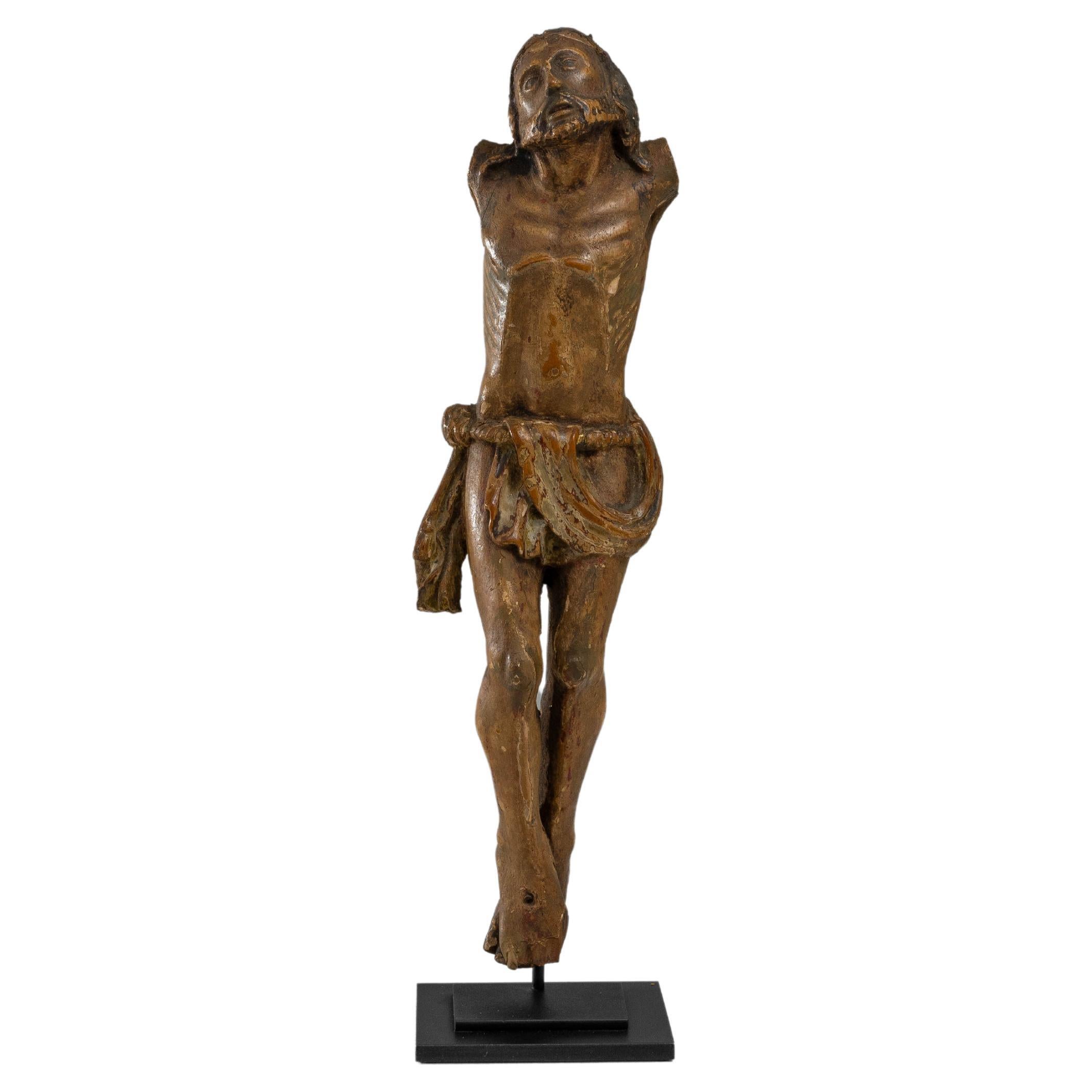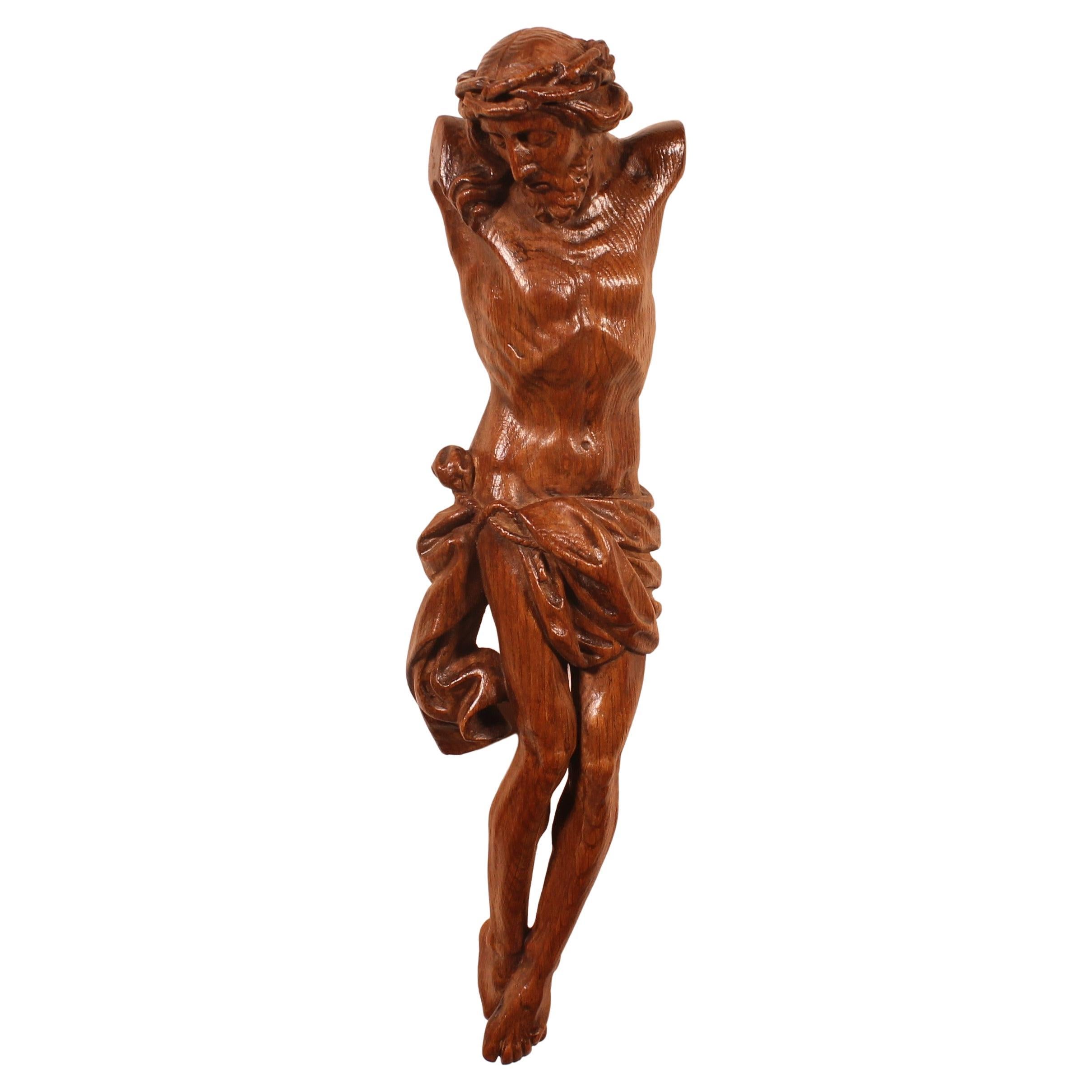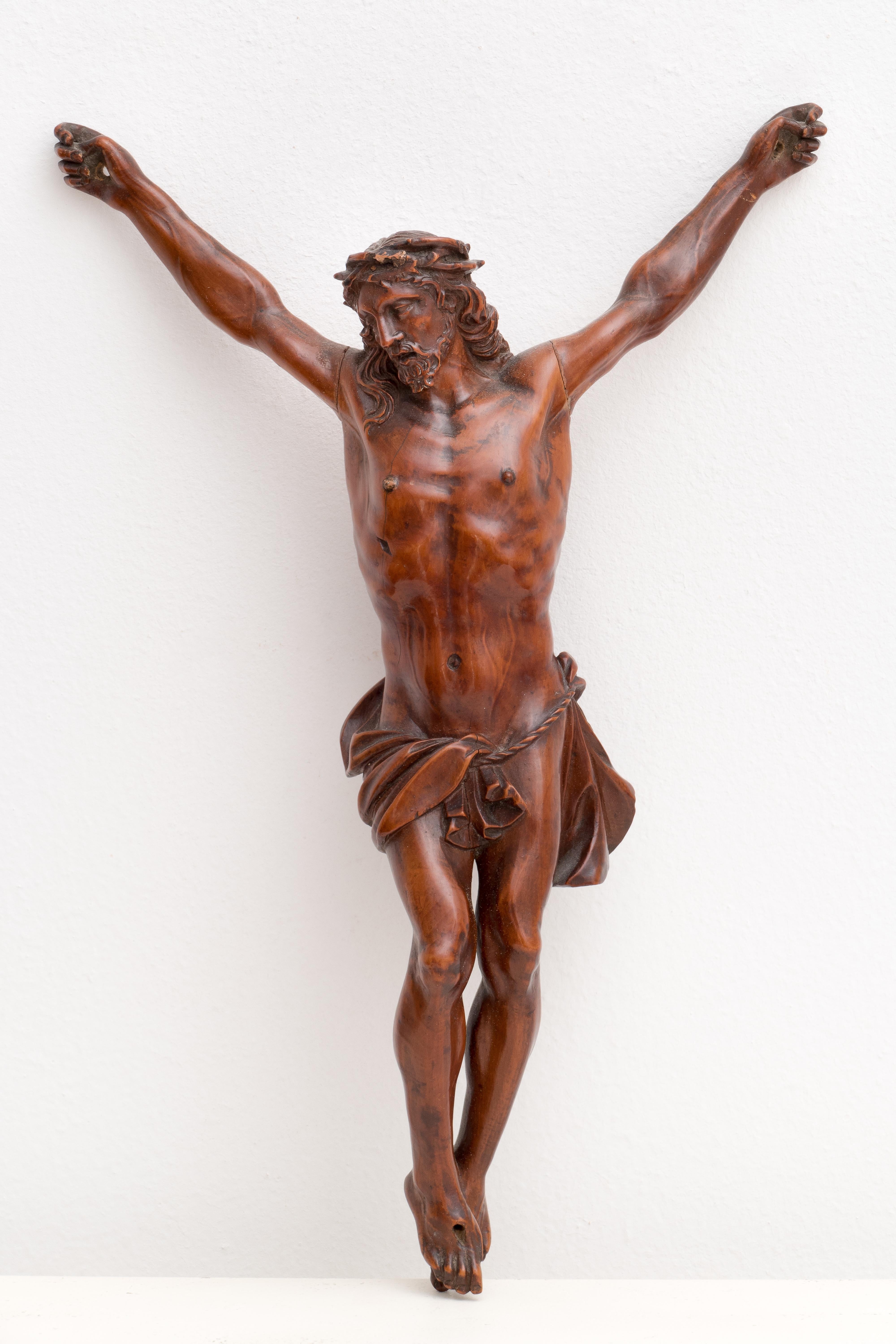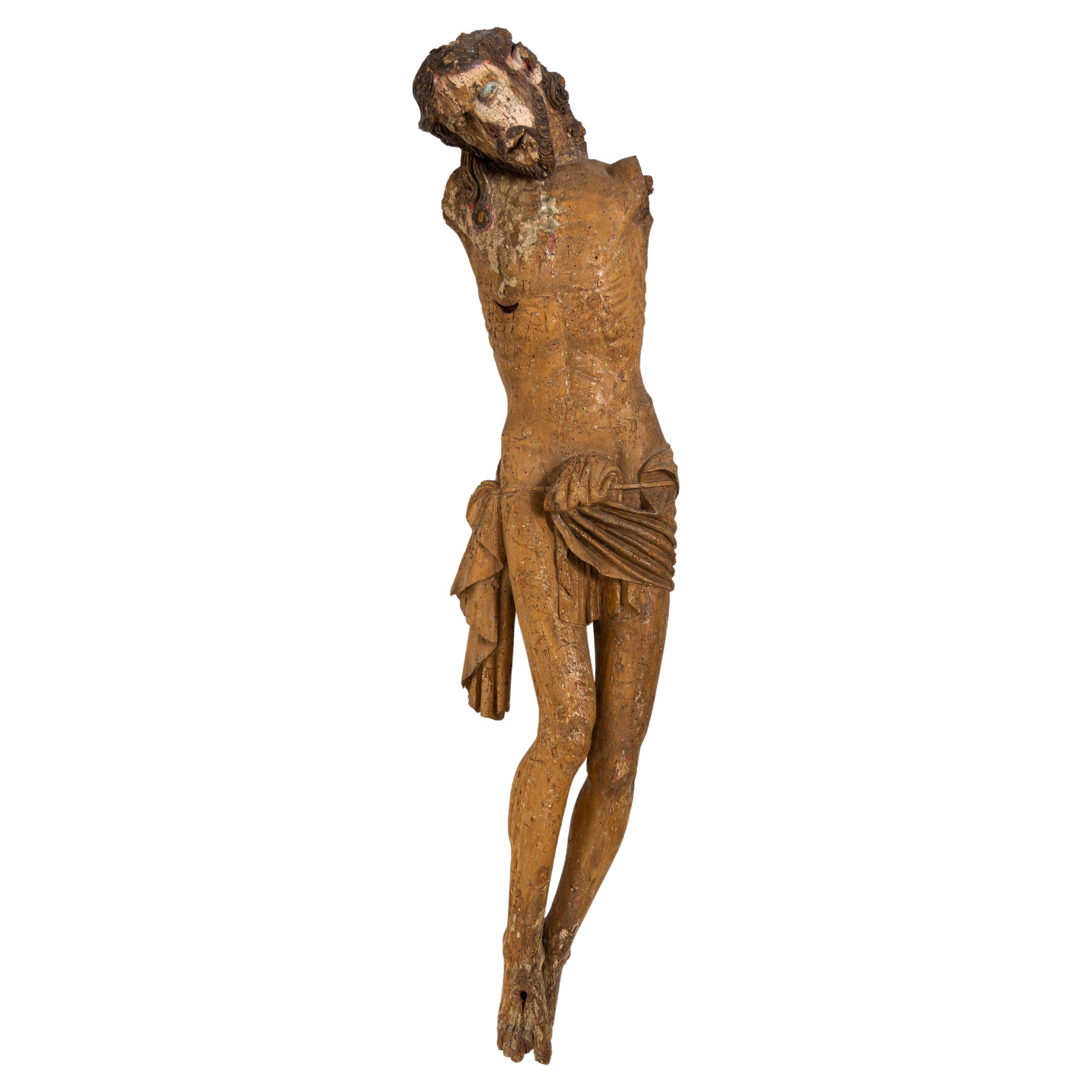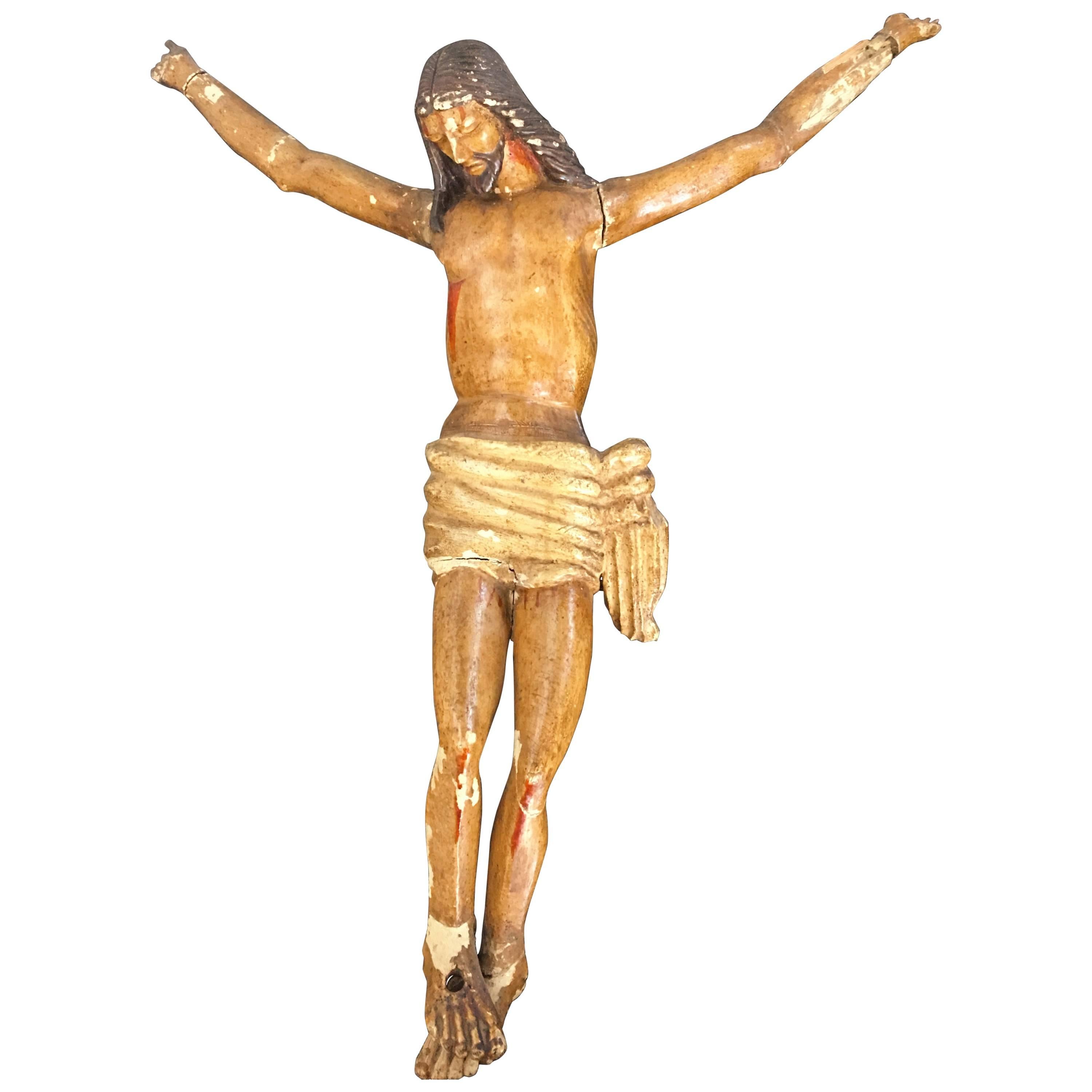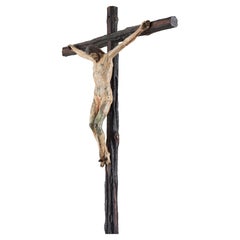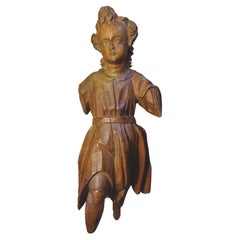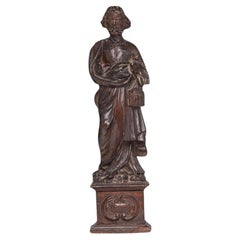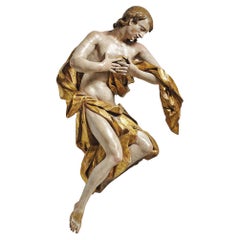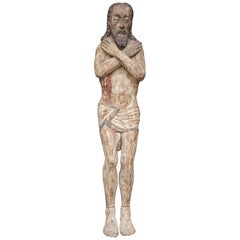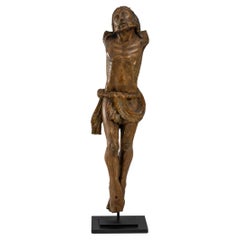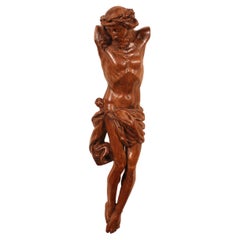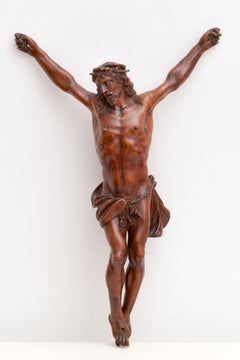Items Similar to A Rustic Wooden 17th century Baroque Flemish Corpus of Christ
Want more images or videos?
Request additional images or videos from the seller
1 of 8
A Rustic Wooden 17th century Baroque Flemish Corpus of Christ
$2,295
£1,742.65
€1,992.85
CA$3,206.45
A$3,566.27
CHF 1,862.20
MX$43,397.71
NOK 23,783.08
SEK 22,304.33
DKK 14,873.39
Shipping
Retrieving quote...The 1stDibs Promise:
Authenticity Guarantee,
Money-Back Guarantee,
24-Hour Cancellation
About the Item
Anonymous
Belgium; ca. 1650-1700
Wood (walnut?)
Approximate size: 22.75 (h) x 18.5 (w) x 10 (d) in.
The scale of this sculpture indicates its original setting was either in the central apse of a small provincial church, a private chapel or the side chapel of a larger church. The unusually squat character of this Christ with his low slung and slightly enlarged head may indicate it was to be viewed by an attendant congregation below.
The chunky, flaring perizonium is in keeping with an earlier Baroque modality with the residual tastes of an earlier Gothic sentiment still present. The expired face of Christ recalls Northern French influences, with a touch of those working in the Lille region, although the carving of this crucifix likely took place in Flanders in what was possibly a provincial workshop. The stocky physiognomy and rotundness and weight of Christ’s features is unique and serves as a stark fleshy contrast to the more common European depictions of Christ as an emaciated figure. This lends to an ambience of dull suffering rather than a sharp final moment and gives this sculpture a rustic and aged character that beckons a different kind of contemplation.
Condition: 20th century restorations have been introduced, inclusive of a replacement to the upper left bicep of Christ’s proper left arm and the entire proper right arm being altogether replaced up to the antique join. A further restoration may have been introduced to the reverse of the sculpture, along the proper left calf of Christ. Such restorations are not uncommon in an attempt to preserve historic artifacts within churches and institutions. The remaining artwork is in a condition commensurate with age with various dings, scratches, minor chips or losses and old worming, particularly present along the verso of the sculpture where moisture would have accumulated when mounted to an old wooden cross or against a church wall.
Please note, this item ships from our storage facility in Belgium and will require additional time to pack and ship to the USA.
- Dimensions:Height: 22.75 in (57.79 cm)Width: 18.5 in (46.99 cm)Depth: 10 in (25.4 cm)
- Style:Baroque (Of the Period)
- Materials and Techniques:
- Place of Origin:
- Period:Late 17th Century
- Date of Manufacture:unknown
- Condition:Replacements made: A replacement to the upper left bicep of Christ’s proper left arm and the entire proper right arm being altogether replaced up to the antique join.2295. Wear consistent with age and use.
- Seller Location:Leesburg, VA
- Reference Number:1stDibs: LU8166241542992
About the Seller
4.7
Vetted Professional Seller
Every seller passes strict standards for authenticity and reliability
Established in 2013
1stDibs seller since 2023
43 sales on 1stDibs
Typical response time: 2 hours
- ShippingRetrieving quote...Shipping from: Bruxelles, Belgium
- Return Policy
Authenticity Guarantee
In the unlikely event there’s an issue with an item’s authenticity, contact us within 1 year for a full refund. DetailsMoney-Back Guarantee
If your item is not as described, is damaged in transit, or does not arrive, contact us within 7 days for a full refund. Details24-Hour Cancellation
You have a 24-hour grace period in which to reconsider your purchase, with no questions asked.Vetted Professional Sellers
Our world-class sellers must adhere to strict standards for service and quality, maintaining the integrity of our listings.Price-Match Guarantee
If you find that a seller listed the same item for a lower price elsewhere, we’ll match it.Trusted Global Delivery
Our best-in-class carrier network provides specialized shipping options worldwide, including custom delivery.More From This Seller
View AllRare and important painted bronze Crucifix after a model by Michelangelo
By Michelangelo Buonarroti
Located in Leesburg, VA
A rare and very fine bronze corpus of Christ after a model by Michelangelo, cast ca. 1597-1600 by Juan Bautista Franconio and painted in 1600 by Francisco Pacheco in Seville, Spain.
The present corpus reproduces a model attributed to Michelangelo. The best known example, lesser in quality, is one on display at the Metropolitan Museum of Art (MET).
The association of this corpus with Michelangelo was first brought to light by Manuel Gomez-Moreno (1930-33) who studied the wider circulated casts identified throughout Spain. The attribution to Michelangelo was subsequently followed by John Goldsmith-Phillips (1937) of the MET and again by Michelangelo expert, Charles de Tolnay (1960).
While Michelangelo is best known for his monumental works, there are four documented crucifixes he made. The best known example is the large-scale wooden crucifix for the Church of Santa Maria del Santo Spirito in Florence, made in 1492 as a gift for the Prior, Giovanni di Lap Bicchiellini, for allowing him to study the anatomy of corpses at the hospital there. In 1562, Michelangelo wrote two letters to his nephew, Lionardo, indicating his intention to carve a wooden crucifix for him. In 1563 a letter between Lionardo and the Italian sculptor Tiberio Calcagni, mentions this same crucifix (a sketch of a corpus on the verso of a sheet depicting Michelangelo’s designs for St. Peter’s Basillica [Palais des Beaux-Arts in Lille] may reproduce this). That Michelangelo was working on small corpora in the last years of his life is further evidenced by the small (26.5 cm) unfinished wooden crucifix located at the Casa Buonarroti, considered his last known sculptural undertaking. Michelangelo’s contemporary biographer, Giorgio Vasari additionally cites that Michelangelo, in his later years, made a small crucifix for his friend, Menighella, as a gift.
Surviving sketches also indicate Michelangelo’s study of this subject throughout his career, most notably during the end of his life but also during the 1530s-40s as he deepened his spiritual roots. The occasional cameo of crucified Christ’s throughout his sketched oeuvre have made it challenging for scholars to link such sketches to any documented commissions of importance. All the while, in consideration that such objects were made as gifts, it is unlikely they should be linked with commissions.
Nonetheless, a number of theories concerning Michelangelo’s sketches of Christ crucified have been proposed and some may regard the origin of the present sculpture. It has been suggested that the corpus could have its impetus with Michelangelo’s work on the Medici Chapel, whose exclusive design was given to the master. It is sensible smaller details, like an altar cross, could have fallen under his responsibility (see for example British Museum, Inv. 1859,0625.552). Others have noted the possibility of an unrealized large marble Crucifixion group which never came to fruition but whose marble blocks had been measured according to a sheet at the Casa Buonarroti.
A unique suggestion is that Michelangelo could have made the crucifix for Vittoria Colonna, of whom he was exceedingly fond and with whom he exchanged gifts along with mutual spiritual proclivities. In particular, Vittoria had an interest in the life of St. Bridget, whose vision of Christ closely resembles our sculpture, most notably with Christ’s proper-left leg and foot crossed over his right, an iconography that is incredibly scarce for crucifixes. The suggestion could add sense to Benedetto Varchi’s comment that Michelangelo made a sculpted “nude Christ…he gave to the most divine Marchesa of Pescara (Vittoria Colonna).”
Of that same period, two sketches can be visually linked to our sculpture. Tolnay relates it to a sketch of a Crucified Christ at the Teylers Museum (Inv. A034) of which Paul Joannides comments on its quality as suggestive of preparations for a sculptural work. Joannides also calls attention to a related drawing attributed to Raffaello da Montelupo copying what is believed to be a lost sketch by Michelangelo. Its relationship with our sculpture is apparent. Montelupo, a pupil of Michelangelo’s, returned to Rome to serve him in 1541, assisting with the continued work on the tomb of Pope Julius II, suggesting again an origin for the corpus ca. 1540.
The earliest firm date that can be given to the present corpus is 1574 where it appears as a rather crudely conceived Crucifixion panel, flanked by two mourners in low-relief and integrally cast for use as the bronze tabernacle door to a ciborium now located at the Church of San Lorenzo in Padula. Etched in wax residue on the back of the door is the date, 27 January 1574, indicating the corpus would have at least been available as a model by late 1573.
The Padula tabernacle was completed by Michelangelo’s assistant, Jacopo del Duca and likely has its origins with Michelangelo’s uncompleted tabernacle for the Basilica of St. Mary of the Angels in Rome.
The impetus for the Padula tabernacle’s Crucifixion panel begins with a series of late Crucifixion sketches by Michelangelo, depicting a scene of Christ crucified and flanked by two mourners (see British Museum Inv. 1895.0915.510; Ashmolean Museum Inv. 1846.89, KP II 343 recto; Windsor Castle RCIN 912761 recto; and Louvre Inv. 700). A faintly traced block possibly intended for sculpting the sketch of the crucified Christ on its recto was discovered by Tolnay on a version of the composition at Windsor Castle. The Windsor sketch and those related to it appear to have served as preparatory designs for what was probably intended to become the Basilica of St. Mary’s tabernacle door. Vasari documents that the project was to be designed by Michelangelo and cast by his assistant, Jacopo del Duca. Michelangelo died before the commission was complete, though on 15 March 1565, Jacopo writes to Michelangelo’s nephew stating, “I have started making the bronze tabernacle, depending on the model of his that was in Rome, already almost half complete.” Various circumstances interrupted the completion of the tabernacle, though its concept is later revitalized by Jacopo during preparations to sell a tabernacle, after Michelangelo’s designs, to Spain for Madrid’s El Escorial almost a decade later. The El Escorial tabernacle likewise encountered problems and was aborted but Jacopo successfully sold it shortly thereafter to the Carthusians of Padula.
An etched date, 30 May 1572, along the base of the Padula tabernacle indicates its framework was already cast by then. A 1573 summary of the tabernacle also describes the original format for the door and relief panels, intended to be square in dimension. However, a last minute decision to heighten them was abruptly made during Jacopo’s negotiations to sell the tabernacle to King Phillip II of Spain. Shortly thereafter the commission was aborted. Philippe Malgouyres notes that the Padula tabernacle’s final state is a mixed product of the original design intended for Spain’s El Escorial, recycling various parts that had already been cast and adding new quickly finished elements for its sale to Padula, explaining its unusually discordant quality, particularly as concerns the crudeness of the door and relief panels which were clearly made later (by January 1574).
Apart from his own admission in letters to Spain, it is apparent, however, that Jacopo relied upon his deceased master’s designs while hastily realizing the Padula panels. If Michelangelo had already earlier conceived a crucifix model, and Jacopo had access to that model, its logical he could have hastily employed it for incorporation on the door panel to the tabernacle. It is worth noting some modifications he made to the model, extending Christ’s arms further up in order to fit them into the scale of the panel and further lowering his chin to his chest in order to instill physiognomic congruence. A crude panel of the Deposition also follows after Michelangelo’s late sketches and is likewise known by examples thought to be modifications by Jacopo based upon Michelangelo’s initial sculptural conception (see Malgouyres: La Deposition du Christ de Jacopo del Duca, chef-d’oeuvre posthume de Michel-Ange).
Jacopo’s appropriation of an original model by Michelangelo for more than one relief on the Padula tabernacle adds further indication that the crucifix was not an object unique to Jacopo’s hand, as few scholars have posited, but rather belongs to Michelangelo’s original...
Category
Antique 16th Century Renaissance Figurative Sculptures
Materials
Bronze
Baroque Period Bohemian Wooden Angel Sculpture Fragment
Located in Leesburg, VA
Rococo Period Bohemian Wooden Angel Sculpture Fragment
Anonymous
Bohemia; ca. 1700
Oak
Approximate size: 17 (h) x 7 (w) x 4.75 (d) in.
The present oakwood sculpture, with its cinc...
Category
Antique Early 1700s Czech Rococo Wall-mounted Sculptures
Materials
Oak
An antique 18th century Walnut European Santos - Saint figure on a plinth
Located in Leesburg, VA
An antique 18th century Walnut Figural Statue of Saint Peter on a plinth
Anonymous
Northern Europe, probably Belgium; first-half of the 18th century
Walnut
Approximate size: 17 (h) x 4.25 (w) x 4.25 (d) in.
The present sculpture, perfectly suited for a curiosity cabinet or English-European country styled home, was likely realized for a church side chapel or choir stall niche. The serious look of the saint’s face...
Category
Antique Early 18th Century Belgian Baroque Figurative Sculptures
Materials
Walnut
18th century Polychrome and Giltwood Angel from the ambit of Franz Ignaz Gunther
Located in Leesburg, VA
A large polychrome and gilt limewood sculpture of an Angel in the Manner of Franz Ignaz Gunther, ca. 1770, Munich (Bavaria)
Approximate size: 107 c...
Category
Antique Mid-18th Century German Rococo Wall-mounted Sculptures
Materials
Wood
19th Century Articulated Wooden Figure of the Virgin Mary
Located in Leesburg, VA
19th century articulated wooden figure of the Virgin Mary
Anonymous
Spain; 19th century
Polychrome wood, inset glass eyes
Approximate size: 37 x 11 x 7 cm
An antique ‘Virgin...
Category
Antique 19th Century Primitive Figurative Sculptures
Materials
Glass, Wood, Paint
$2,363 Sale Price
24% Off
18th century Antique Wood-carved Santo figure in later Tabernacle
Located in Leesburg, VA
18th century Antique Wood-carved Santo figure in later Tabernacle
Anonymous
Spain or Spanish Americas; 18th century
Polychrome wood (santo); oak (tabernacle)
Approximate size: 18.5...
Category
Antique Mid-18th Century Spanish Spanish Colonial Figurative Sculptures
Materials
Wood, Oak
You May Also Like
Baroque Figure of Crucified Christ
Located in Hudson, NY
This unusual Baroque figure of Christ carved circa 1670 and 1700 is in a form associated with his removal from the cross after crucifixion but before his...
Category
Antique Late 17th Century Spanish Baroque Wall-mounted Sculptures
Materials
Wood
18th Century French Wooden Sculpture of Jesus on Metal Stand
Located in High Point, NC
This 18th Century French Wooden Sculpture of Jesus on a Metal Stand is a profound piece of religious art that exudes a sense of history and devotion. Carved with reverent detail from...
Category
Antique 18th Century French Figurative Sculptures
Materials
Metal
Christ 18 ° Century in Oak, France
Located in Brussels, Brussels
Christ from the 18th century in oak -France
Very fine work of good quality
Beautiful patina and in perfect condition.
Category
Antique 18th Century French Louis XIV Figurative Sculptures
Materials
Oak
ANTIQUE ITALIAN 18TH CENTURY BOXWOOD SCULPTURE OF CHRIST
Located in Milan, IT
Boxwood figure of Christ
Category
18th Century Figurative Sculptures
Materials
Wood
Christ Sculpture, 17th Century
Located in Greding, DE
Almost life-size Christ sculpture of the 17th century. Wood carved and set.
Category
Antique 17th Century Italian Figurative Sculptures
Materials
Wood
18th Century Carved Wooden Representing Christ on the Cross
Located in Miami, FL
Carved wooden representing Christ on the cross.
Category
Antique Late 18th Century Spanish Neoclassical Religious Items
Materials
Wood, Paint
More Ways To Browse
Gothic Crucifix
Antique Church Artifacts
Wood Corpus Of Christ
Large Wooden Crucifix
17th Century Cross Crucifix
Antique Obi
Antique Onyx Mantel Clocks
Antique Petticoat
Antique Pine 3 Drawer Chest
Antique Pine Server
Antique Pocket Doors
Antique Porch Chairs
Antique Puppet
Antique Safe Locks
Antique Sculptures Rooster
Antique Sheet Music Storage Cabinet
Antique Stationary Box
Antique Stirling
